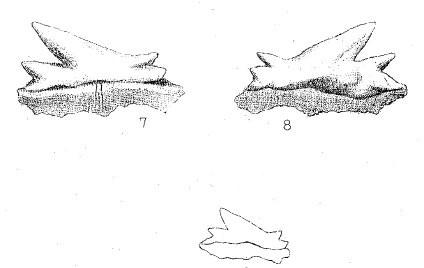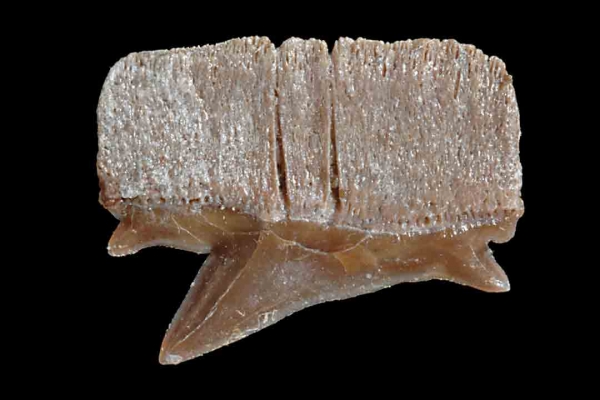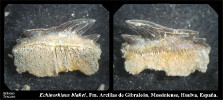Echinorhinus blakei
Agassiz, 1856
Classification: Elasmobranchii Echinorhiniformes Echinorhinidae
Reference of the original description
Notice on the fossil fishes found in California by W.P. BLAKE. American Journal of Science and Arts, Series 2, 21, 272–275
Notice on the fossil fishes found in California by W.P. BLAKE. American Journal of Science and Arts, Series 2, 21, 272–275
Image of the original description

Echinorhinus blakei Agassiz, 1856; In: Agassiz, 1857, p. 313, Plate 1, Fig. 7, 8

Echinorhinus blakei Agassiz, 1856; In: Agassiz, 1857, p. 313, Plate 1, Fig. 7, 8
Description by Pollerspoeck, Juergen:
Benediktinerring 34, D-94569 Stephansposching; juergen.pollerspoeck@shark-references.comCitation: Echinorhinus blakei Agassiz, 1856: In: Database of fossil elasmobranch teeth www.shark-references.com, World Wide Web electronic publication, Version 01/2026
Please send your images of "Echinorhinus blakei" to info@shark-references.com

Echinorhinus blakei Agassiz, 1856; Beaufort County, Miocene, Size: 0.4" Owned By: Richard Chandler © Richard Chandler, USA

Echinorhinus blakei Agassiz, 1856; Beaufort County, Miocene, Size: 0.4" Owned By: Richard Chandler © Richard Chandler, USA
Distribution Geographic
type locality: Ocoya creek (posé creek), Sierra Nevada, California [26];
other localities: Lee Creek Mine, Aurora, North Carolina PURDY et. al. 2001 p. 86 [1964]; REINECKE et. al., 2011 p 13, Werder-Uesen, northwestern Lower Saxony, Germany [13836]; Huelva City, SW Spain [pers. comment Antonio Toscano Grande, Universidad de Huelva];
Distribution of Echinorhinidae show google map
type locality: Ocoya creek (posé creek), Sierra Nevada, California [26];
other localities: Lee Creek Mine, Aurora, North Carolina PURDY et. al. 2001 p. 86 [1964]; REINECKE et. al., 2011 p 13, Werder-Uesen, northwestern Lower Saxony, Germany [13836]; Huelva City, SW Spain [pers. comment Antonio Toscano Grande, Universidad de Huelva];
Distribution of Echinorhinidae show google map
Distribution Stratigraphy
Temblor Formation, Round Mountain Silt, upper Member, Sharktooth Hill bone-bed horrizon [2517]; Pungo River Formation PURDY et. al. 2001 p. 86 [1964]; REINECKE et. al., 2011 p. 13, Lower Mica Fine Sand Formation, late Burdigalian, Miocene [13836]; Gibraleón Clays Formation (Fm. Arcillas de Gibraleón), Messinian, [pers. comment Antonio Toscano Grande, Universidad de Huelva];
Temblor Formation, Round Mountain Silt, upper Member, Sharktooth Hill bone-bed horrizon [2517]; Pungo River Formation PURDY et. al. 2001 p. 86 [1964]; REINECKE et. al., 2011 p. 13, Lower Mica Fine Sand Formation, late Burdigalian, Miocene [13836]; Gibraleón Clays Formation (Fm. Arcillas de Gibraleón), Messinian, [pers. comment Antonio Toscano Grande, Universidad de Huelva];
Material
PURDY et. al. 2001 p. 86 [1964]: 13 complete teeth and fragments of teeth, USNM 207608, 207609, 280334, 281317, 281331, 287739, 287740, 412221, 457232-57236; REINECKE et. al., 2011 p 13, 4 teeth [13836]; Antonio Toscano Grande, 2014: 1 tooth
PURDY et. al. 2001 p. 86 [1964]: 13 complete teeth and fragments of teeth, USNM 207608, 207609, 280334, 281317, 281331, 287739, 287740, 412221, 457232-57236; REINECKE et. al., 2011 p 13, 4 teeth [13836]; Antonio Toscano Grande, 2014: 1 tooth
Description
Original diagnosis after AGASSIZ 1856 [26]: Echinorhinus Blakei, Agassiz.—One of the most interesting and important discoveries since the publication of the "Poissons Fossiles” is that of the tooth of the genus Echinorhinus, in the tertiary deposits of Ocoya creek (Posé creek), at the western base of the Sierra Nevada, California. The genus Echinorhinus was founded by Blainville for the Squalus spinosus of Linnaeus, the only species of the genus thus far known which inhabits the Mediteranean and the European and African coasts of the Atlantic. I figured the teeth of the same genus under the name of Goniodus for the same species, (see Poissons Fossiles, vol. III, p. 94, pl. E, fig. 13,) so that this name must give way to the Echinorhinus of Blainville. The discovery of a fossil species of this genus in the tertiaries of the western slope of the Sierra Nevada is not only important as carrying back this curious type of sharks to a period older than ours, but also in disclosing the existence upon the American continent of types in a fossil state known in the old world only among the living. The fossil species of Echinorhinus differs from the living, having the main point of the tooth more prominent, and at the same time shorter, an appearance which arises from the less prominence of the marginal denticles. This difference may be distinctly seen by comparing the figures with those of the living species given in Poissons Fossiles, pl. E, fig. 13." Diagnosis after WELTON, 1979 [2517]: - no more than two mesial and distal cusplets; - cusp erect, mesial notch usually well developed; - distal notch well developed and distally extended as in E. cookei; - mesial cutting ridge of cusp coarsely serrated and irregular in outline, all other cutting ridges finely serrated; - lingual transverse ridges on crown foot weakly developed or usually absent
Original diagnosis after AGASSIZ 1856 [26]: Echinorhinus Blakei, Agassiz.—One of the most interesting and important discoveries since the publication of the "Poissons Fossiles” is that of the tooth of the genus Echinorhinus, in the tertiary deposits of Ocoya creek (Posé creek), at the western base of the Sierra Nevada, California. The genus Echinorhinus was founded by Blainville for the Squalus spinosus of Linnaeus, the only species of the genus thus far known which inhabits the Mediteranean and the European and African coasts of the Atlantic. I figured the teeth of the same genus under the name of Goniodus for the same species, (see Poissons Fossiles, vol. III, p. 94, pl. E, fig. 13,) so that this name must give way to the Echinorhinus of Blainville. The discovery of a fossil species of this genus in the tertiaries of the western slope of the Sierra Nevada is not only important as carrying back this curious type of sharks to a period older than ours, but also in disclosing the existence upon the American continent of types in a fossil state known in the old world only among the living. The fossil species of Echinorhinus differs from the living, having the main point of the tooth more prominent, and at the same time shorter, an appearance which arises from the less prominence of the marginal denticles. This difference may be distinctly seen by comparing the figures with those of the living species given in Poissons Fossiles, pl. E, fig. 13." Diagnosis after WELTON, 1979 [2517]: - no more than two mesial and distal cusplets; - cusp erect, mesial notch usually well developed; - distal notch well developed and distally extended as in E. cookei; - mesial cutting ridge of cusp coarsely serrated and irregular in outline, all other cutting ridges finely serrated; - lingual transverse ridges on crown foot weakly developed or usually absent
Discussion
WELTON, 1979 [2517] guess that the type locality is the Sharktooth Hill ("Round Mountain Silt, upper Member, Sharktooth Hill bonebed horizon (Mitchell, 1965:4 and Lawrence G. Barnes, personal communication). Although neither Blake nor Agassiz ever designated a formal 1ithostratigraphic unit from which the teeth were collected (because none existed until Anderson's 1911 definition of the Temblor Formation), there seems to be good evidence that the shark teeth were collected in the same bone-bed as that found at Sharktooth Hill. Blake (1857:171) noted that "On the tops of two hills opposite camp a great number of shark's teeth of different sizes were lying loose on the surface, having been washed out by the rains." The Sharktooth Hill bone-bed horizon is known to crop out in the immediate vicinity of Blake's campsite along the south side of Pose Creek and out of the three shark producing lithostratigraphic units in the area (Jewett Sand, approximately 1.5 miles to the N.E., Olcese Sand, in the immediate area north'of Pose Creek, and the Round Mountain Silt, both north and south of the Creek), only the Round Mountain Silt, Sharktooth Hill bone-bed horizon is likely to have produced the surface concentration and taxonomic assemblage which Blake and Agassiz describe.")
WELTON, 1979 [2517] guess that the type locality is the Sharktooth Hill ("Round Mountain Silt, upper Member, Sharktooth Hill bonebed horizon (Mitchell, 1965:4 and Lawrence G. Barnes, personal communication). Although neither Blake nor Agassiz ever designated a formal 1ithostratigraphic unit from which the teeth were collected (because none existed until Anderson's 1911 definition of the Temblor Formation), there seems to be good evidence that the shark teeth were collected in the same bone-bed as that found at Sharktooth Hill. Blake (1857:171) noted that "On the tops of two hills opposite camp a great number of shark's teeth of different sizes were lying loose on the surface, having been washed out by the rains." The Sharktooth Hill bone-bed horizon is known to crop out in the immediate vicinity of Blake's campsite along the south side of Pose Creek and out of the three shark producing lithostratigraphic units in the area (Jewett Sand, approximately 1.5 miles to the N.E., Olcese Sand, in the immediate area north'of Pose Creek, and the Round Mountain Silt, both north and south of the Creek), only the Round Mountain Silt, Sharktooth Hill bone-bed horizon is likely to have produced the surface concentration and taxonomic assemblage which Blake and Agassiz describe.")
Remarks
shark-references Species-ID=2060;
valid after Pfeil (1983) p. 205 [1886]; Reinecke et al. (2011) p. 13 [13836];
shark-references Species-ID=2060;
valid after Pfeil (1983) p. 205 [1886]; Reinecke et al. (2011) p. 13 [13836];
References
The Cartilaginous Fishes (Chimaeras, Sharks, and Rays) of Calvert Cliffs, Maryland, USA. In The Geology and vertebrate paleontology of Calvert Cliffs, Maryland / edited by Stephen J. Godfrey: 45-157
Echinorhinus caspius, Echinorhinus richiardii, Echinorhinus pollerspoecki, Echinorhinus schoenfeldi, Echinorhinus cf. riepli, Echinorhinus priscus, Paraechinorhinus riepli, Echinorhinus sp., Echinorhinus pfauntschi, Echinorhinus blakei, Echinorhinus pozzii, Echinorhinus kelleyi, Echinorhinus weltoni, Echinorhinus eyrensis, Echinorhinus australis, Gibbechinorhinus lewyi, Orthechinorhinus pfeili, In Database of fossil elasmobranchteeth, www.shark–references.com, World Wide Web electronic publication, Version 04/2013

Oldest evidence of bramble sharks (Elasmobranchii, Echinorhinidae) in the Lower Cretaceous of southeast France and the evolutionary history of orbitostylic sharks. (plus Supplementary data). Cretaceous Research, 35, 81–87
DOI: 10.1016/j.cretres.2011.11.021

Neogene and Quaternary Fossils of North Carolina, A Field Guide. North Carolina Fossil Club, Durham, 58 p.

The elasmobranch fauna of the late Burdigalian, Miocene, at Werder-Uesen, Lower Saxony, Germany, and its relationships with Early Miocene faunas in the North Atlantic, Central Paratethys and Mediterranean. Palaeontos, 20, 1–170

Fossil Shark Teeth of the World. Lamna Books, 170 p
The Neogene sharks, rays, and bony fishes from Lee Creek Mine, Aurora, North Carolina. In Geology and paleontology of the Lee Creek Mine, North Carolina, III, Clayton E. RAY & David J. BOHASKA. Smithsonian Contributions to Paleobiology, 90: 71–202, 84fig., 1 tabl.

Haaien- en roggentanden uit Liessel (N.-B.) Fontys Hogescholen, Tilburg

Fossil Sharks of the Chesapeake Bay Region. Egan Rees and Boyer, Inc. Columbia. 146 pp.

Zahnmorphologische Untersuchungen an rezenten und fossilen Haien der Ordnungen Chlamydoselachiformes und Echinorhiniformes. Palaeo Ichthyologica, 1, 1–315

Late Cretaceous and Cenozoic Squalomorphii of the Northwest Pacific Ocean. PhD, Univ. of California Berkeley, 553 p., 71 fig.
Fossil sharks and rays of the Pacific slope of North America. Bulletin of the Southern California Academy of Sciences, 22, 27–63, pl. 1–10
Fossil fishes of southern california, Part II. Fossil Fishes of the Miocene (Monterey) Formations. Stanford University Publications, University Series: 13–60

Supplementary notes on fossil sharks. Bulletin Department of Geology, University of California, 7, 243–256

The fossil fishes of California with supplementary notes on other species of extinct fishes. Bulletin Department of Geology, University of California, 5(7), 95–145

Bibliography and catalogue of the fossil Vertebrata of North America. Bulletin of the United States Geological and Geographical Survey of the Territories, 179, 1–868
Notice of the fossil fishes. In Reports of explorations and surveys, to ascertain the most practicable and economical route for a railroad from the Mississippi River to the Pacific Ocean, Volumes I to X, 5: 313–316
The Cartilaginous Fishes (Chimaeras, Sharks, and Rays) of Calvert Cliffs, Maryland, USA. In The Geology and vertebrate paleontology of Calvert Cliffs, Maryland / edited by Stephen J. Godfrey: 45-157
Echinorhinus caspius, Echinorhinus richiardii, Echinorhinus pollerspoecki, Echinorhinus schoenfeldi, Echinorhinus cf. riepli, Echinorhinus priscus, Paraechinorhinus riepli, Echinorhinus sp., Echinorhinus pfauntschi, Echinorhinus blakei, Echinorhinus pozzii, Echinorhinus kelleyi, Echinorhinus weltoni, Echinorhinus eyrensis, Echinorhinus australis, Gibbechinorhinus lewyi, Orthechinorhinus pfeili, In Database of fossil elasmobranchteeth, www.shark–references.com, World Wide Web electronic publication, Version 04/2013

Oldest evidence of bramble sharks (Elasmobranchii, Echinorhinidae) in the Lower Cretaceous of southeast France and the evolutionary history of orbitostylic sharks. (plus Supplementary data). Cretaceous Research, 35, 81–87
DOI: 10.1016/j.cretres.2011.11.021

Neogene and Quaternary Fossils of North Carolina, A Field Guide. North Carolina Fossil Club, Durham, 58 p.

The elasmobranch fauna of the late Burdigalian, Miocene, at Werder-Uesen, Lower Saxony, Germany, and its relationships with Early Miocene faunas in the North Atlantic, Central Paratethys and Mediterranean. Palaeontos, 20, 1–170

Fossil Shark Teeth of the World. Lamna Books, 170 p
The Neogene sharks, rays, and bony fishes from Lee Creek Mine, Aurora, North Carolina. In Geology and paleontology of the Lee Creek Mine, North Carolina, III, Clayton E. RAY & David J. BOHASKA. Smithsonian Contributions to Paleobiology, 90: 71–202, 84fig., 1 tabl.

Haaien- en roggentanden uit Liessel (N.-B.) Fontys Hogescholen, Tilburg

Fossil Sharks of the Chesapeake Bay Region. Egan Rees and Boyer, Inc. Columbia. 146 pp.

Zahnmorphologische Untersuchungen an rezenten und fossilen Haien der Ordnungen Chlamydoselachiformes und Echinorhiniformes. Palaeo Ichthyologica, 1, 1–315

Late Cretaceous and Cenozoic Squalomorphii of the Northwest Pacific Ocean. PhD, Univ. of California Berkeley, 553 p., 71 fig.
Fossil sharks and rays of the Pacific slope of North America. Bulletin of the Southern California Academy of Sciences, 22, 27–63, pl. 1–10
Fossil fishes of southern california, Part II. Fossil Fishes of the Miocene (Monterey) Formations. Stanford University Publications, University Series: 13–60

Supplementary notes on fossil sharks. Bulletin Department of Geology, University of California, 7, 243–256

The fossil fishes of California with supplementary notes on other species of extinct fishes. Bulletin Department of Geology, University of California, 5(7), 95–145

Bibliography and catalogue of the fossil Vertebrata of North America. Bulletin of the United States Geological and Geographical Survey of the Territories, 179, 1–868
Notice of the fossil fishes. In Reports of explorations and surveys, to ascertain the most practicable and economical route for a railroad from the Mississippi River to the Pacific Ocean, Volumes I to X, 5: 313–316


















